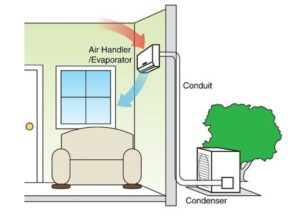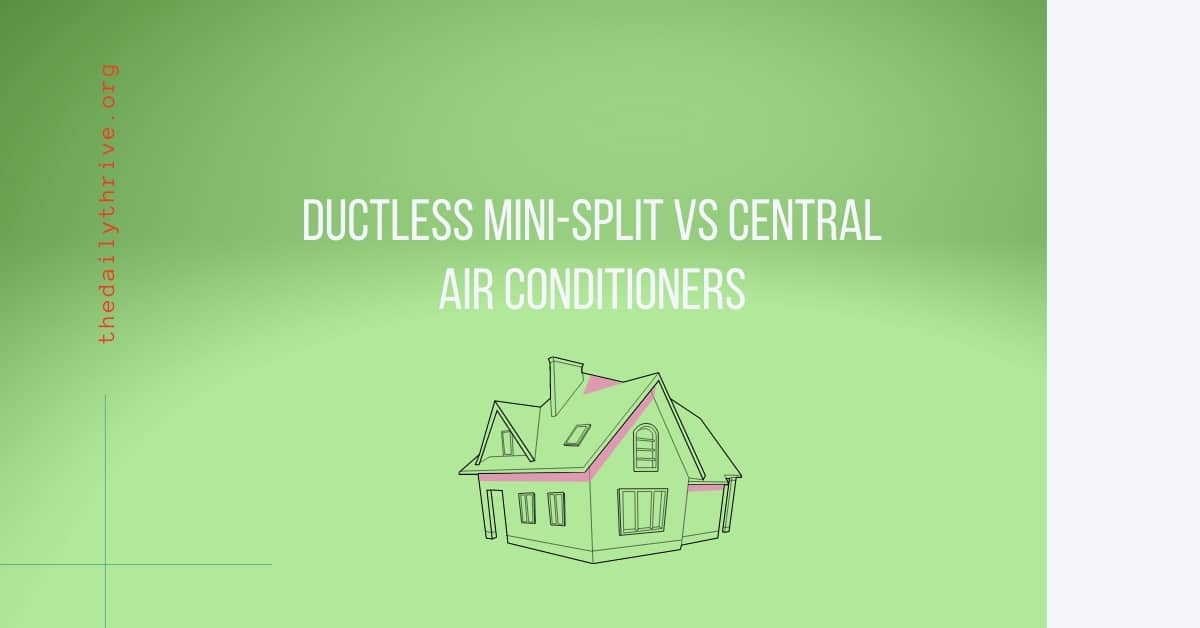If you looking for a new air conditioning system for your home then you may be wondering if it’s better to get ductless mini-split or central air conditioning system. Ductless mini-split and central air conditioners are both popular options for cooling homes and businesses. Which one is right for you will depend on your specific needs and preferences.
If you prioritize energy efficiency and easy installation, a ductless mini-split may be the best option. If you have an existing ductwork system and want a cost-effective option, a central air conditioner may be a better choice.
What exactly is different between these two cooling devices? Here are some of the key differences between ductless mini-split vs central air conditioners:
- Installation: Central air conditioners require ductwork to distribute cool air throughout a building, while ductless mini-splits do not. This can make ductless mini-splits a more attractive option for buildings where ductwork installation would be difficult or costly.
- Energy efficiency: Ductless mini-splits are generally more energy-efficient than central air conditioners because they don’t experience the energy losses associated with ductwork. They also allow for zoned cooling, meaning you can cool specific areas of a building instead of cooling the entire building.
- Cost: The cost of ductless mini-splits can be higher than central air conditioners, especially if you need to install multiple units to cool a larger space. However, the lower energy costs over time can offset this initial cost difference.
- Maintenance: Both types of air conditioning systems require regular maintenance to keep them running efficiently. However, ductless mini-splits tend to be easier to maintain because they have fewer components and don’t require duct cleaning.
- Aesthetics: Ductless mini-splits can be more aesthetically pleasing than central air conditioners because they are smaller and can be mounted on walls or ceilings. Central air conditioners require large outdoor units and ductwork that can be unsightly.
Ductless Mini-Split Air Conditioning System

The ductless air conditioner is also called the split-type air conditioner. What this means is you don’t have to punch holes through your walls or windows. All you need to do is mount the air conditioning unit on your wall. The ducts of your air conditioner will be located outside the wall of your home or near the ceiling of your room. This will enable you to save lots of space as well.
This kind of unit is also commonly used in hotels and offices wherein they have rooms that do not have any wall facing the outside of the building. If you want the walls of your home to look cleaner and more appealing – without the butts of air conditioners jutting out of it – then you should buy ductless air conditioners.
Another great thing about this kind of air conditioning unit is that it is very powerful and operates silently. Certain units can even cool an entire home when functioning normally. Since the evaporator is located far from the motor of the unit, it will be able to produce cold air faster and more efficiently.
One more benefit of using this device is that you it can function as a heat pump during the winter. This will save you the hassle of buying a separate heating system for your home or office. Silence is also a very important factor when it comes to choosing the right air conditioner. You can work best and relax well when staying in a room that is serene and silent.
Ductless Mini-Split Pros and Cons
Ductless mini-split air conditioners have become increasingly popular in recent years as an alternative to central air conditioning systems. Here are some of the main pros and cons of mini-split air conditioners:
Pros:
- Energy efficiency: Ductless mini-splits are generally more energy-efficient than central air conditioners because they don’t experience the energy losses associated with ductwork. Additionally, they allow for zoned cooling, meaning you can cool specific areas of a building instead of cooling the entire building.
- Easy installation: Mini-splits do not require ductwork, which can be costly and time-consuming to install. This makes them a popular option for buildings where ductwork installation would be difficult or costly.
- Flexible placement: Mini-splits can be installed in various locations and are more flexible in terms of placement, as they can be mounted on walls or ceilings.
- Quiet operation: Mini-splits are known for their quiet operation, making them an excellent choice for residential or commercial spaces where noise can be a concern.
- Better air quality: Without ductwork, there is less opportunity for dirt, dust, and other allergens to accumulate, resulting in better indoor air quality.
Cons:
- Higher initial cost: Mini-splits can be more expensive than traditional central air conditioning systems.
- Maintenance: Mini-splits require regular maintenance to keep them running efficiently, just like any other air conditioning system.
- Multiple units may be required: Depending on the size of the space you are trying to cool, you may need to install multiple mini-split units, which can increase the overall cost.
- Aesthetics: While mini-splits can be installed in various locations, they may still be visible and may not blend in with the decor of your space.
Central Air Conditioning System
Central Air Conditioning System is what the most people are familiar with. It makes sense that peoples have chosen to install these kind of units in their homest. However, just because it is what we know doesn’t necessarily mean it’s to best option when choosing a new air conditioning system .
A central air conditioning system treats air at a central location and distributes it to and from rooms by one or more fans and a series of ducts. Supply ducts and registers carry this cool air from the air conditioner to the home. The air becomes warmer as it circulates through the home; then it flows back to the central air conditioner through return ducts and registers.
The system is usually installed outdoors, although in some cases they may be mounted on your roof or in your attic. Because they are not part of your living areas, they are relatively unobtrusive, with only the vents showing.
Central AC Pros and Cons
Here are some of the main pros and cons of central air conditioning:
Pros:
- Cost-effective: Central air conditioning systems can be a more cost-effective option for cooling larger spaces, as they require fewer units to cool the same amount of space.
- Even cooling: Central air conditioning systems provide even cooling throughout the entire space, without the need for additional units or adjustments.
- Aesthetics: The outdoor unit of a central air conditioning system can be placed out of sight, making it a more visually appealing option for many people.
- Low maintenance: Central air conditioning systems require less maintenance than ductless mini-splits, as they have fewer units to maintain and no filters to clean.
- Improved air quality: Central air conditioning systems use filters to improve indoor air quality by removing dust, pollen, and other allergens from the air.
Cons:
- High installation cost: Central air conditioning systems can be more expensive to install than ductless mini-splits, especially if you don’t already have ductwork in place.
- Ductwork issues: If you have existing ductwork, it may need to be cleaned or repaired before installing a central air conditioning system. Additionally, ductwork can leak and cause energy loss, reducing the efficiency of the system.
- Limited control: With a central air conditioning system, you can only adjust the temperature of the entire space, rather than individual rooms or zones.
- Energy loss: Ductwork can result in energy loss, reducing the overall efficiency of the system.
Conclusion
There are many things you need to take into consideration when choosing the right kind of air conditioner for your home.
Firstly, you need to set your budget. By having a maximum amount of what you can spend in mind, you will be able to narrow down you list of units significantly. You should also figure out how strong an air conditioner you need in order to cool your room correctly. This will enable you to choose an air conditioning unit that is powerful enough for your needs.
You should also be sure to only buy units manufactured by the best and most reputable brands. This way, you can be assured that the unit you buy will be of good quality. Also, you should have your units installed by a team of qualified professionals. This will ensure that your air conditioners will work very well and for a long time to come.
Overall, the decision to install wether ductless mini-split or a central air conditioning system will depend on your specific needs. A mini-split air conditioners are an excellent option for energy efficiency, easy installation, and flexible placement. A central air conditioning system are a cost-effective option for larger spaces and can provide even cooling throughout the entire home.
While this article should help get you started, it’s always best to talk to a heating and cooling professional to make sure you’re getting all the facts as they relate to your home. Both mini split or central air conditioning require a professional for correct sizing and placement so that system runs effectively and at peak performance.






